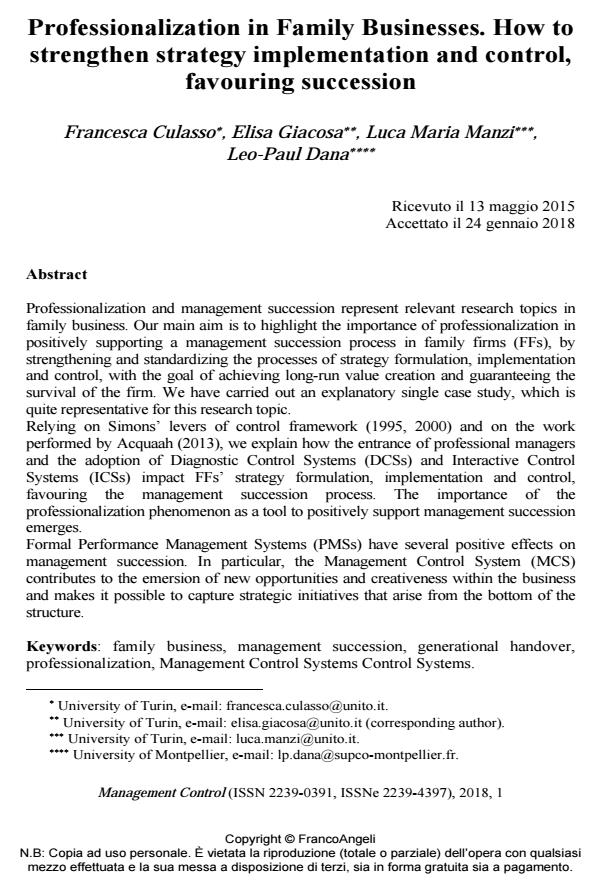Professionalization in Family Businesses. How to strengthen strategy implementation and control, favouring succession
Journal title MANAGEMENT CONTROL
Author/s Francesca Culasso, Elisa Giacosa, Luca Maria Manzi, Leo-Paul Dana
Publishing Year 2018 Issue 2018/1
Language English Pages 27 P. 45-71 File size 261 KB
DOI 10.3280/MACO2018-001003
DOI is like a bar code for intellectual property: to have more infomation
click here
Below, you can see the article first page
If you want to buy this article in PDF format, you can do it, following the instructions to buy download credits

FrancoAngeli is member of Publishers International Linking Association, Inc (PILA), a not-for-profit association which run the CrossRef service enabling links to and from online scholarly content.
Professionalization and management succession represent relevant research topics in family business. Our main aim is to highlight the importance of professionalization in positively supporting a management succession process in family firms (FFs), by strengthening and standardizing the processes of strategy formulation, implementation and control, with the goal of achieving long-run value creation and guaranteeing the survival of the firm. We have carried out an explanatory single case study, which is quite representative for this research topic. Relying on Simons’ levers of control framework (1995, 2000) and on the work performed by Acquaah (2013), we explain how the entrance of professional managers and the adoption of Diagnostic Control Systems (DCSs) and Interactive Control Systems (ICSs) impact FFs’ strategy formulation, implementation and control, favouring the management succession process. The importance of the professionalization phenomenon as a tool to positively support management succession emerges. Formal Performance Management Systems (PMSs) have several positive effects on management succession. In particular, the Management Control System (MCS) contributes to the emersion of new opportunities and creativeness within the business and makes it possible to capture strategic initiatives that arise from the bottom of the structure.
Keywords: Family business, management succession, generational handover, professionalization, Management Control Systems Control Systems.
- An Investigation of Factors Towards Family Business Sustainability: Perspective from India, a Developing Economy Nandini Varshney, Sucheta Agarwal, Leo Paul Dana, Amit Kumar Dwivedi, in Journal of Family and Economic Issues /2024
DOI: 10.1007/s10834-024-09997-1 - Management Controlling and Governance of Family Businesses Cristiana Cattaneo, Gaia Bassani, pp.29 (ISBN:978-3-030-47740-0)
- Management Controlling and Governance of Family Businesses Gaia Bassani, Cristiana Cattaneo, Francesca M. Cesaroni, Annalisa Sentuti, pp.161 (ISBN:978-3-030-47740-0)
- The Impact of the Management Control System on the Family Business’ Intention to Maintain the Organization for Future Generations Fábio Frezatti, Diógenes de Souza Bido, Daniel Magalhães Mucci, Franciele Beck, Ana Paula Capuano da Cruz, in Journal of the Knowledge Economy /2023 pp.1145
DOI: 10.1007/s13132-022-00918-x - The knowing–doing gap: Family SMEs and sustainability in Germany and Sweden Börje Boers, Thomas Henschel, Adrian Ade, Stefan Kemp, in Journal of the International Council for Small Business /2025 pp.55
DOI: 10.1080/26437015.2024.2390868
Francesca Culasso, Elisa Giacosa, Luca Maria Manzi, Leo-Paul Dana, Professionalization in Family Businesses. How to strengthen strategy implementation and control, favouring succession in "MANAGEMENT CONTROL" 1/2018, pp 45-71, DOI: 10.3280/MACO2018-001003